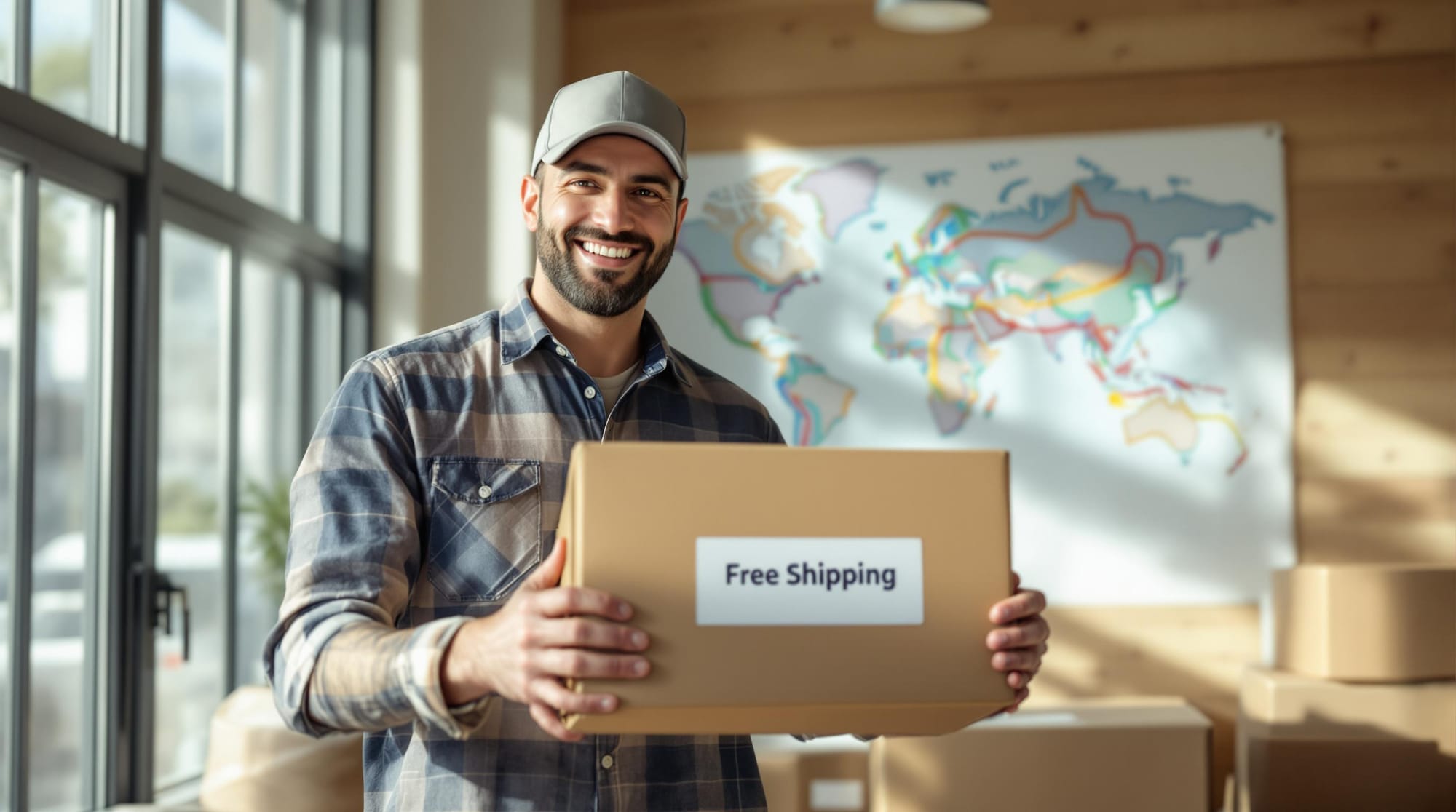Free Shipping Messaging: Local vs. Global Strategies
Explore effective local and global free shipping strategies to enhance customer satisfaction and drive sales in your e-commerce business.

- Local Free Shipping: Targets specific regions, lowers costs, and speeds up delivery. Ideal for regional businesses and cost-focused operations but has limited reach and higher logistical complexity.
- Global Free Shipping: Covers international markets, expands reach, and builds loyalty but comes with higher costs, slower delivery, and complex regulations.
Quick Comparison:
| Aspect | Local Strategies | Global Strategies |
|---|---|---|
| Cost | Lower shipping costs | Higher expenses (customs, logistics) |
| Reach | Regional customers | International audiences |
| Delivery Speed | Faster and predictable | Slower due to longer transit |
| Logistics | Easier with local carriers | Complex international regulations |
| Customer Focus | Tailored to local needs | Consistent global offerings |
Key Tip: Combine both strategies for flexibility. Use tools like progress bars and dynamic thresholds to nudge customers toward free shipping while balancing costs.
Keep reading for actionable tips and examples to optimize your approach.
How to Correctly Add Shopify Shipping Rates - Flat Rates and Carrier Calculated Rates Explained

Local Free Shipping Strategies
When deciding between local and global free shipping, it's essential to weigh the pros and cons of each approach. Local free shipping strategies allow businesses to thrive in specific regions while keeping costs in check.
Benefits of Local Strategies
Focusing on local markets can lower shipping costs and speed up delivery times - two major factors for customer satisfaction. Partnering with local delivery services often leads to better rates and tighter control over expenses. This approach is especially effective in addressing the concerns of the 23% of shoppers who abandon carts due to slow delivery times . Tailoring free shipping thresholds to match a region's purchasing power can also encourage more sales and improve customer experience.
Potential Drawbacks of Local Strategies
Despite their advantages, local strategies do have limitations. The biggest challenge is limited reach, as these strategies are confined to specific areas. Managing separate campaigns for different regions can also become a logistical headache, requiring careful attention to varying shipping rules and thresholds.
| Challenge | Impact | Solution |
|---|---|---|
| Limited reach | Smaller customer base | Focus on growing within key regions |
| Campaign complexity | Higher operational workload | Use automated tools for smoother management |
| Logistics coordination | Dependence on local couriers | Partner with reliable, trusted couriers |
Real-World Examples
Take Walmart, for instance. Their $35 free shipping threshold is customized for specific regions, aligning with local customer expectations and boosting average order value (AOV) .
Businesses can apply local strategies effectively by:
- Setting region-specific free shipping thresholds based on market research.
- Collaborating with local couriers to offer affordable same-day delivery.
Tools like dynamic shipping bars and in-cart offer builders can help highlight these thresholds, encouraging customers to take action in targeted areas.
While local strategies focus on precision and meeting regional needs, global strategies aim to accommodate a broader, international audience.
Global Free Shipping Strategies
Global free shipping caters to international markets, offering a broader reach compared to localized approaches. When done effectively, it can work alongside local strategies to create a balanced model that boosts both market penetration and operational efficiency.
Why Global Strategies Work
Free shipping on a global scale can drive growth for businesses aiming to expand internationally. For example, studies show that 47% of consumers are willing to spend more to qualify for free shipping . This behavior leads to higher average order values across different regions.
Some key benefits include:
- Reaching new international markets
- Gaining a competitive edge globally
- Building customer loyalty with consistent offerings worldwide
Common Challenges and Solutions
While global free shipping has its perks, it also comes with hurdles. Businesses need to find the right balance between customer expectations and operational costs. Here's a breakdown:
| Challenge | Impact | Solution |
|---|---|---|
| High shipping costs | Lower profit margins | Set minimum order thresholds |
| Delivery delays internationally | Dissatisfied customers | Communicate clear delivery timelines |
| Customs and regulations | Complications in fulfillment | Partner with reliable global carriers |
Real-World Examples and Tactics
Some big names have nailed their global shipping game. Take Jeffree Star Cosmetics, for instance. They set higher spending requirements for international free shipping to manage costs while keeping customers happy by being upfront about policies .
Dynamic tools like progress bars also play a huge role in optimizing strategies. Features like these can:
- Show how close customers are to earning free shipping
- Use localized currency and shipping info for clarity
- Motivate customers to add more to their cart
Pairing free shipping with loyalty programs can amplify results. In fact, 42% of consumers join loyalty programs specifically for free shipping perks . This approach not only helps offset costs but also strengthens customer relationships over time.
Balancing global and local strategies is key to creating a seamless experience for customers while maintaining profitability.
Comparison of Local and Global Free Shipping Strategies
Understanding the differences between local and global free shipping strategies can help businesses choose approaches that best fit their objectives and resources.
Differences in Audience and Costs
Local strategies focus on regional delivery, often leveraging partnerships with nearby carriers to keep costs low. On the other hand, global strategies involve higher expenses due to extended shipping distances, customs fees, and more complex logistics. While local shipping benefits from streamlined networks and quicker delivery, global shipping expands market reach but comes with added challenges and costs.
Pros and Cons of Each Strategy
| Aspect | Local Strategies | Global Strategies |
|---|---|---|
| Cost Management | Lower delivery costs, efficient local networks | Higher expenses, includes customs fees |
| Market Reach | Limited to regional customers | Access to international audiences |
| Delivery Speed | Faster, more predictable times | Slower due to longer transit |
| Logistics | Easier to manage with local carriers | Requires handling international regulations |
| Customer Experience | Builds loyalty within local markets | Appeals to a global customer base |
| Risk Level | Fewer risks in transit | Increased potential for issues during shipping |
These insights provide a framework for weighing the benefits and challenges of each approach.
Choosing the Right Strategy
Several factors play a role in deciding between local and global shipping:
- Product and Budget: High-margin products and larger budgets can support global shipping, while low-margin items may be better suited for cost-efficient local options.
- Target Market: Knowing where your customers are located is crucial. For instance, 47% of consumers are willing to spend more if free shipping is offered . Analyzing geographic trends can guide your decision.
- Operational Setup: Local strategies align well with existing regional networks, while global shipping requires partnerships with international logistics providers.
Tools like progress bars and in-cart offers can boost both strategies by showing customers how close they are to free shipping thresholds. This tactic is especially effective, as 42% of consumers join loyalty programs specifically for shipping perks .
The key is to align your shipping strategy with your business's strengths while clearly communicating terms to customers. Whether focusing locally or internationally, setting realistic delivery expectations can build trust and drive sales.
Best Practices for Free Shipping Messaging
Clear Messaging
Make sure your free shipping offers are easy to understand and highly visible. Clearly state any requirements, like minimum purchase thresholds, so customers know exactly what they need to do. Use prominent placements like header banners, product pages, and cart progress bars to keep this information front and center at every stage of the shopping journey.
Adding dynamic progress bars that update in real-time can make a big difference. These bars, which show how close a customer is to earning free shipping, have been shown to encourage 78% of shoppers to add more items to their cart . The clearer and more interactive the messaging, the more effective it becomes.
Using Tools for Messaging
Modern tools can take your free shipping messaging to the next level by making it more engaging and actionable. For example, apps like CRO Cart Drawer & Cart Upsells for Shopify provide features like real-time progress tracking and personalized product suggestions, helping to increase average order value (AOV) and reduce cart abandonment.
| Feature | How It Helps |
|---|---|
| Dynamic Progress Bar | Shows real-time progress toward free shipping goals |
| AI Product Recommendations | Suggests items to help meet shipping thresholds |
| A/B Testing Capability | Fine-tunes messaging for better performance |
| Multi-language Support | Ensures clear communication across regions |
These tools address a key issue: 23% of shoppers abandon carts due to concerns about delivery costs . By making free shipping more understandable and accessible, you can keep more customers engaged.
Tailoring Offers
Customize your free shipping deals based on customer behavior and geographic data. For example, setting the free shipping threshold just above your average order value can encourage shoppers to add an extra item. Meanwhile, region-specific offers can help you appeal to both local and international audiences.
You can also use category-specific free shipping promotions strategically, such as to:
- Move surplus inventory
- Highlight high-margin products
- Boost sales during slow seasons
- Introduce new items to your catalog
"The key to successful free shipping messaging lies in optimizing packaging and considering partial free shipping options to boost average order values while maintaining profitability" .
Conclusion
Key Takeaways
Deciding between local and global free shipping strategies can greatly influence the success of an e-commerce business. Studies indicate that 47% of shoppers are willing to meet a minimum spending requirement to access free shipping , proving its effectiveness in boosting conversions. Local strategies are ideal for addressing specific regional needs while keeping costs manageable. On the other hand, global strategies open doors to wider markets but come with higher operational expenses.
By weighing the pros and cons of each method, businesses can develop strategies that enhance both profitability and customer experience. With 27% of shoppers blending online and offline purchases , it's crucial to integrate both channels into your shipping plans.
| Strategy Type | Ideal Scenarios |
|---|---|
| Local | Regional businesses, cost-focused operations, bulky or heavy products |
| Global | Digital goods, lightweight products, targeting international audiences |
Practical Steps for Businesses
To put these insights into action, consider the following steps for crafting a free shipping strategy that works:
- Understand your audience: Dive into customer demographics and shipping cost data to identify trends.
- Set smart thresholds: Use data to create spending limits that encourage purchases while protecting margins.
- Leverage e-commerce tools: Implement features like dynamic shipping bars and AI-driven recommendations to optimize offers.
- Communicate clearly: Ensure your free shipping terms are transparent and consistent across all platforms.
- Experiment and adjust: Test different offers and refine them based on performance.
- Balance expectations and costs: Align customer needs with what’s feasible for your business operations.
Success in free shipping requires ongoing fine-tuning and a focus on both customer happiness and sustainable growth.
